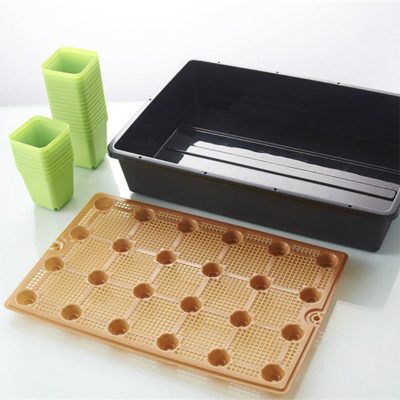Plant trays are indeed an essential tool for seed starting and transplanting. They provide a convenient and organized way to sow seeds, nurture seedlings, and facilitate the transplanting process. Here are some benefits and uses of plant trays:
- Seed Starting: Plant trays are commonly used for seed starting. They have multiple individual cells or compartments where you can sow seeds. The cells help maintain the proper spacing between seedlings, making it easier to manage and track their growth. Plant trays also help prevent cross-contamination of different seed varieties.
- Moisture Control: Plant trays often come with built-in drainage holes or bottom trays to collect excess water. This allows for proper drainage and prevents waterlogging, which can be detrimental to seedlings. The trays also help maintain moisture levels by preventing evaporation, ensuring that the seeds or seedlings receive consistent hydration.
- Transplanting Aid: Once seedlings have reached an appropriate size, plant trays make it easier to transplant them into larger pots or garden beds. The individual cells allow for easy removal of seedlings without disturbing their roots. This minimizes transplant shock and improves the success rate of transplants.
- Organization and Space Efficiency: Plant trays help keep your seedlings organized and save space. They can be stacked or lined up neatly, making efficient use of limited gardening space, such as windowsills or shelves. The uniform size and shape of the cells also make it easier to manage and move seedlings around.
- Versatility: Plant trays are available in various sizes and cell configurations, allowing you to choose the one that suits your specific needs. You can find trays with different cell counts, ranging from a few cells to dozens, depending on the number of seeds you plan to start. This versatility makes plant trays suitable for both small-scale home gardening and larger-scale production.
- Reusability: Many plant trays are made from durable and reusable materials like plastic or recycled materials. With proper care and sanitation, you can use them season after season, reducing waste and saving money in the long run.
When using plant trays, it’s important to ensure proper sanitation and cleanliness to prevent the spread of diseases. Wash trays before each use and sterilize them if necessary. Additionally, provide adequate light, warmth, and moisture to promote healthy seedling growth.
Overall, plant trays are a valuable tool for seed starting and transplanting, providing an organized and efficient system for nurturing seedlings until they are ready for the garden.








